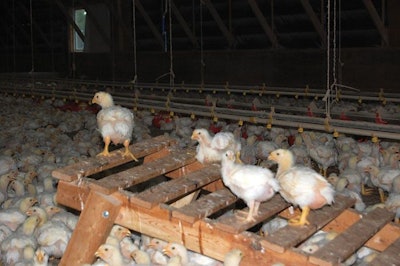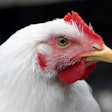
A significant group of U.S. and Canadian restaurant chains, food service distributors and food processors recently pledged to purchase chicken meat from broilers raised according to Global Animal Partnership (GAP) standards by some future date. One part of many of these GAP welfare pledges is that the breed of broilers selected to be grown to produce the meat purchased will have demonstrably better welfare than others.
Most welfare standards for poultry do not make breed specifications, rather they are either resource- or outcome-based welfare standards and the choice of breed is left up to the producer. If producers are to make breed selections based on bird welfare, then research is needed to compare breeds based on objective welfare measurements.
The Campbell Centre for the Study of Animal Welfare received funding from both GAP and Food From Thought to conduct research to evaluate the welfare and sustainability of modern and slow-growing breeds of broilers. Dr. Stephanie Torrey, senior research scientist, and Dr. Tina M. Widowski, director of the Campbell Centre, are heading up the “Optimizing Broiler Project.” The initial phase of the project commenced in September 2017.
The objectives of the project are to:
- Validate behavioral and physiological indicators of welfare for three fast-growing genotypes under standard production practices.
- Benchmark data on the welfare of slow-growing genotypes and compare to fast-growing genotypes. Genotypes will be assessed on behavior, physiology, health, production as well as carcass and meat quality.
- Determine nutrient utilization and benchmark indices of gut health and function in slow and fast growing genotypes.
The project’s long-term objectives are to:
- Develop a database from which a life cycle assessment can be performed.
- Initiate a study on the economic viability and consumer preferences for slow-growing broilers.
Validating broiler welfare measures
Torrey said animal welfare often is seen as having three components. The first component is biological functioning. Is the bird healthy, or is it sick? Is it lame? The second is the effective state of health, is the bird experiencing fear or stress, or on the other side, is the bird experiencing boredom?
“Then the third pillar that some could argue is not as relevant for modern animals is the natural living," Torrey said. "Is it behaving like a bird?”
Modern breeds may not be as motivated to exhibit all of the natural behaviors of a chicken as some of the heritage or slow-growing breeds are.
When asked about how relevant expression of behaviors is to the welfare of a strain of birds that may only be motivated to move to the feeder, drinker and then sit back down, she said, “If they are not motivated to walk around then that is not part of the their behavioral repertoire, that’s what that bird is, but if it is not walking around because it is lame, because it has pain, because its legs are not just strong enough to hold its body up, or it has to take rest just from moving from one part of the house to the other, if it wants to get access to different resources. That in itself is a welfare concern.”
To access welfare, the researchers will be gait scoring the study birds weekly and physically accessing them for the presence and severity of foot and hock lesions, long bone deformities and presence and severity of crooked toes. Every two weeks some of the birds will be photographed using an infrared camera to evaluate feather coverage and any leg inflammation. Data loggers will be used on a small sample of birds each week to determine overall levels of inactivity. Bird behavior in the pens will be observed live and with use of video to assess activity levels, resource use and comfort behavior on a weekly basis.
Evaluating efficiency and sustainability
In addition to the welfare measurements, a number of sustainability and efficiency measurements will be made in the Optimizing Broiler Project. Feed intakes and body weights will be measured weekly. The cause of death for all mortalities will be determined. At processing, carcass and meat quality will be accessed. Each carcass will be accessed for grade and leg health.
In later phases of the project, blood samples collected at slaughter will be evaluated for plasma corticosterone levels (an indicator of long-term stress), creatine kinase (an indicator of muscle damage), and glucose levels.
In a later stage in the project, a small number of birds from three fast-growing and three slow-growing strains will be raised in metabolic cages. Excreta samples will be collected during starter, grower and finisher phases to measure nutrient retention. In addition, some of the birds will be sacrificed at 8 and 12 weeks of age to collect tissue and digesta samples. Presence of tibia dyschondroplasia lesions will be evaluated as well as bone mineral density, digestive tract development and digestive tract microbial activity (microbiome and microbial metabolites).
Panel discussion on broiler welfare
WATT Global Media will host a discussion of “How to measure and improve broiler welfare” at the International Production and Processing Expo (IPPE) in Atlanta. The event will be held 7:30 – 9:00 a.m. on Thursday February 1, 2018, in room B 213 of the Georgia World Congress Center. Admission is free, but prior registration will be required.
Confirmed panelists:
- Dr. Stephanie Torrey, senior research scientist, animal biosciences, University of Guelph
- Jim Shepard, director of live production for Wayne Farms
- Dr. Joy Mench, professor emeritus, animal science department, University of California at Davis
















